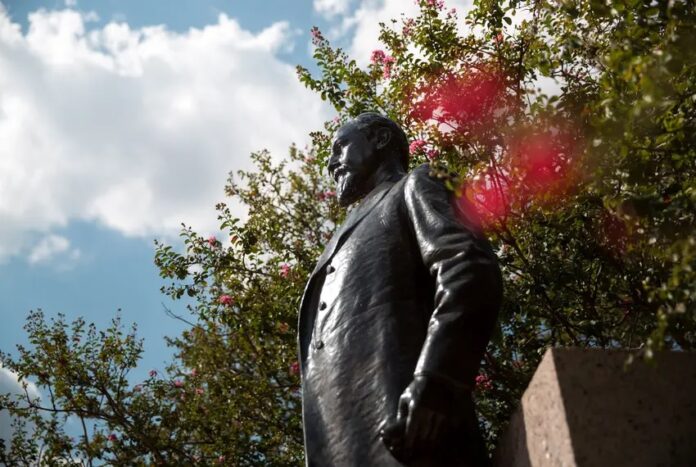By Raga Justin, Texas Tribune
Marking another step in an ongoing struggle at Texas A&M University over a long-venerated Confederate statue, university President Michael Young on Wednesday assembled a task force that will ultimately decide whether to take the statue down.
Following the death of George Floyd while in police custody in Minneapolis, tensions surrounding the statue — which commemorates Confederate general and former Texas Gov. Lawrence Sullivan Ross — reached new heights in recent weeks. Students at Texas A&M’s College Station flagship have zeroed in on it as the campus’ most flagrant reminder of systemic racism.
Young announced Wednesday that he would be forming two groups in response to growing accusations of racism on social media.
“Earlier today I met with Chancellor John Sharp to discuss continued racism on the Texas A&M campus,” Young wrote in a letter. “We discussed posts on social media and emails shared by current and former students about their experiences of racism during their time at Texas A&M. It is time for a unified approach on how we address the representation of people who contributed to Texas A&M throughout our history and how we want to shape the expectations and behavior of our community to stand firmly against racism.”
The task forces will be comprised of current and former students, faculty and subject experts. The first will focus on race relations at the university to “better address racist behavior.” The second, termed a Commission on Historic Representations, will suggest appropriate courses of action for certain statues, monuments and buildings on campus. Young said he would ask this group to make a recommendation for Ross’ statue “in the near future.”
A&M’s leadership has for years deflected calls to remove the statue, noting that the school was struggling when Ross became president in the 1880s and might not have survived without his leadership. In 2018, A&M’s student newspaper ran a letter to the editor calling for the statue’s removal because of Ross’ ties to the Confederacy. A&M System Chancellor John Sharp responded at the time defending the statue, calling the original letter “totally wrong” and arguing that the historically black Prairie View A&M University also likely wouldn’t exist without Ross.
“We are all entitled to our opinion, but we are not entitled to our own wrongheaded facts,” Sharp wrote in 2018. “Lawrence Sullivan Ross will have his statue at Texas A&M forever, not because of obstinance, but because he deserves the honor with a lifetime of service to ALL TEXANS and ALL AGGIES.”
On Wednesday, system spokesman Laylan Copelin released a statement from Sharp reaffirming his opinion on the statue.
“While my personal opinion has not changed about the importance of Lawrence Sullivan Ross to Texas A&M, we Aggies must stand united against racism and love one another,” Sharp’s statement reads. “Racists are not welcome at Texas A&M. If we have to challenge them and call them out publicly, we will… As Chancellor, I pledge my support of the university’s creation today of the Task Force on Race Relations and the Commission on Historic Representations.”
Current and former students have been outspoken about their wish for the administration to remove the statue. Aggie senior quarterback Kellen Mond posted a Twitter statement late Tuesday lambasting Ross’ legacy, which has been linked to white supremacy. Other notable student athletes, including former A&M quarterback and Heisman Trophy winner Johnny Manziel, signaled their support.
Not all Aggies wish to see Ross’ statue removed. A demonstration in College Station last weekend drew hundreds to protest against its removal. More than 24,000 students and alumni have signed a petition to remove the statue, while 25,000 have signed a counter-petition.
The turmoil at A&M mirrors a similar debate at the University of Texas at Austin, where complaints have surged over what students view as racist symbols. Many students have targeted the school song “The Eyes of Texas,” which advocates say has ties to segregation-era minstrel shows, seven campus buildings named for Texans who held racist views, and a statue of prominent segregationist and former Texas Gov. James Hogg.
Prominent UT-Austin athletes also issued an ultimatum demanding that the athletics department donate 0.5% of its earnings to the Black Lives Matter movement, among other actions. If the department does not honor their demands, athletes said they would refuse to participate in recruiting or donor-related events.
Earlier this week, interim President Jay Hartzell responded with a promise to meet with students to discuss further action.




